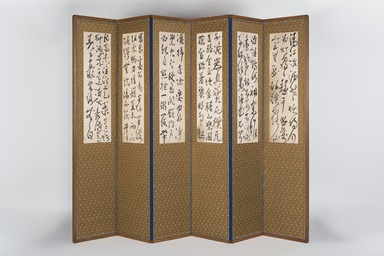
Artist:Jeon Gi
Medium: Six-panel folding screen: ink on paper
Geograhical Locations:
Dates:Second Quarter of 19th century
Dimensions: image: 38 3/16 × 11 13/16 in. (97 × 30 cm) storage (Typically stored in donor's custom blue fabric cover.): 77 × 18 1/2 in., 5 lb. (195.6 × 47 cm, 2.27kg)
Collections:
Accession Number: 2022.37.5
Image: 2022.37.5_PS20.jpg,
Catalogue Description: Six panels of loosely brushed Chinese characters, running vertically. Style fluctuates between legible and very broadly cursive. Content to be translated. Jeon Gi (also known as Goram) was a student of Kim Jung-hi (also known as Wandang or Chu'sa, 1786-1857, the most eminent calligrapher and Chinese classicist of his time in Korea. Together with Cho Hui-ryong (aka Uh-bong, 1797-1859) and Ho Ryon (aka So-chi, 1809-1892), they constituted the Chusa school of calligraphy (named after their teacher's sobriquet), which looked to the Chinese Southern school of calligraphy. Jeon Gi lived to only 30 years old, so his output was small and very few examples of his work survive. There are also paintings in his hand.